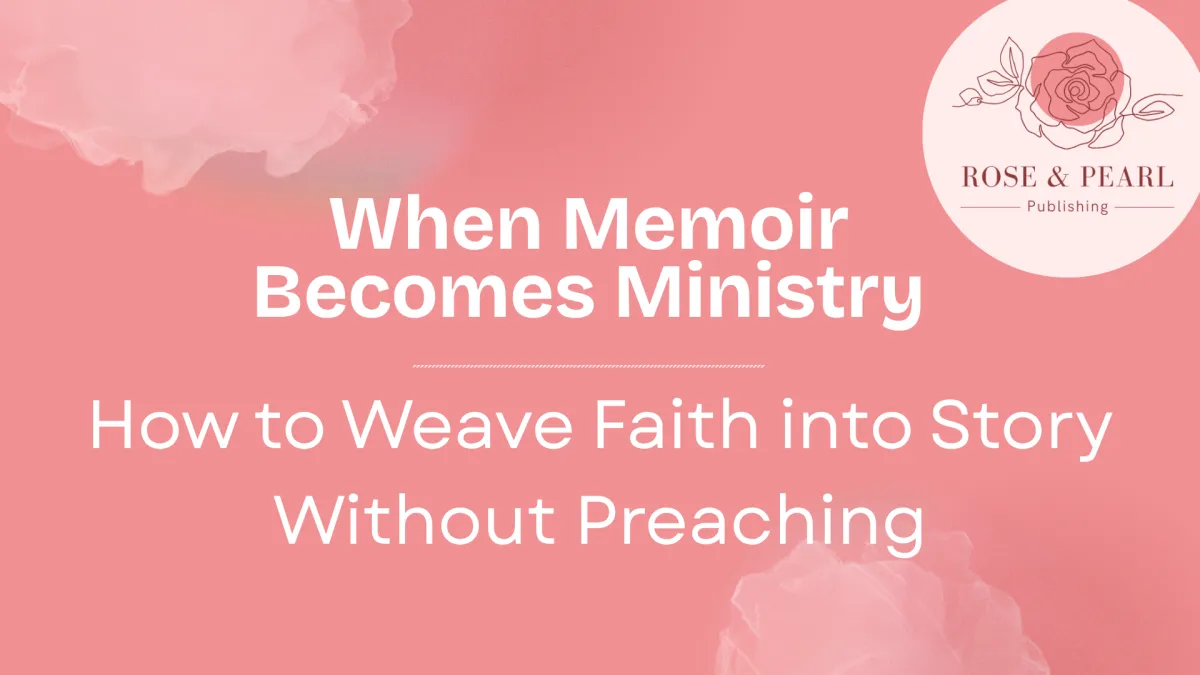
When Memoir Becomes Ministry
When Memoir Becomes Ministry: How to Weave Faith into Story Without Preaching
In our most recent Rose & Pearl release, Facing the Fire, faith is the quiet current under the pages—not an overt sermon. Yet readers notice. Look at the (now) 50+ Amazon reviews: the comment that comes up again and again is that the author’s faith changed them. That’s the point.
Too often memoirs trip into sermon when the author stops showing and starts lecturing. But when faith is lived in scenes—hurts, decisions, small acts of mercy—it becomes contagious. That’s how memoir becomes ministry without being a megaphone.
Below I unpack why subtlety wins and give practical steps to help memoir writers let faith do its deep, persuasive work through story.
Why showing faith beats telling it
Telling: “I trusted God, and He delivered me.”
Showing: a late-night kitchen scene where a trembling hand opens a Bible, a phone call is answered, and a decision is made that changes the next morning’s itinerary.
Readers don’t come for doctrine first; they come for human experience. When you show how belief shaped choices—how prayer sharpened courage, forgiveness rerouted rage, or a small habit shifted identity—you invite readers to experience the spiritual truth rather than be lectured by it. They stay with you; they bring others; your ideas travel.
Three traps that turn memoir into sermon
The Tell-Heavy Paragraph
Paragraphs that summarize emotion or spiritual insight without a scene. (Think: “I forgave because God told me to.”)
The Topical Aside
Sections that pause the narrative to explain doctrine, missionary history, or theological nuance that isn’t tied to the plot.
Audience Assumption
Writing that assumes every reader shares your theological vocabulary—alienating those new to faith or curious readers.
Avoid these, and you keep your story porous: open to skeptics, engaging for seekers, nourishing for believers.
How Facing the Fire did it (and what you can learn)
In Facing the Fire the faith thread is often a feeling or a move, not a paragraph of doctrine. Moments are small—an awkward conversation where shame loses steam, a decision not to retaliate, a quiet habit that changes a morning. Those concrete choices land as spiritual transformation for readers because they’re human and believable.
If your reviews are already telling you the same—readers return to the faith angle even when it isn’t shouted—that’s excellent evidence you’re on the right track. You don’t need to explain every theological nuance; you need to show the human before and after.
Practical craft moves: show faith without preaching
1. Write scenes, not summaries
For every claim of spiritual change, give a scene that made it credible. Show the sensory detail—the smell, the phone call, the small failure—that led to the shift.
2. Use action beats for belief
Faith shows up as action: who the character calls, who they forgive, what they choose to say or not say. Give those beats weight and consequence.
3. Let vulnerability lead
Readers enter a spiritual truth through empathy. Reveal doubts, small betrayals, and the messiness of change. Vulnerability builds trust; trust lets truth enter.
4. Anchor spiritual moments in relationship
Faith often matures inside relationships—spousal conflict, mentor critique, group prayer that shifts a decision. Ground spiritual movement in relational stakes.
5. Keep exposition minimal—and strategic
If theological context is necessary, make it short and earned—preferably voiced by a character (a mentor, a skeptical friend) rather than the narrator’s sermonizing.
6. Use stylistic restraint with Scripture or doctrine
A quotation or a church scene can be enough. Over-explaining doctrine rarely deepens feeling; it usually interrupts narrative momentum.
The Revision Tools (fast, practical)
Faith Scene Audit (15 minutes per chapter)
Mark every time you say a spiritual insight.
Ask: “Does this insight have a scene that earned it?” If no, flag for rewrite.
Show vs Tell Checklist
Tell = summary, label, or explanation.
Show = dialogue, micro-action, sensory detail, consequence.
Keep the ratio in favor of show.
Two-Panel Beta Reading
Panel A: Faith readers (pastors, spiritually mature friends) focused on theological clarity.
Panel B: Secular or unsure readers focused on emotional truth and accessibility.
Reconcile feedback through your non-negotiables (see below).
Decide your non-negotiables
Before you edit, name three elements you will not compromise: a theological anchor? a moral outcome? the honesty of a confession? These are your north star when craft pressure rises.
A quick example rewrite (show, don’t preach)
Tell: “I learned to forgive because God taught me mercy.”
Show: “She pressed her palms flat on the kitchen counter, the apology letter folded in her hand. She wanted to tear it up. Instead she walked to the mailbox and slid it inside. When the neighbor called that night, she didn’t rehearse her defenses—she listened.”
Final thought: memoir as invitation
When you tell the lived truth—without translating it into doctrine—you invite readers into the same journey you walked. That invitation is persuasive because it begins with heart, not argument. Facing the Fire shows that loudness isn’t necessary for spiritual impact; honesty and craft are.
If you’d like, I’ll read a 1-page excerpt and flag where a divine moment is shown vs told—and where a small rewrite could turn a sermon into a scene. Reply with “EXCERPT” and I’ll send next steps.
Grace & clarity,
Carolyn Wiley
Founder, Rose & Pearl Publishing

